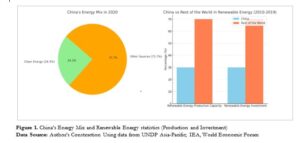The Belt and Road Initiative (BRI) emerged as a colossal and transformative project, stretching its sinews across continents and cultures. Initially perceived as a monumental infrastructural and economic endeavor, the initiative is now steering towards a green and sustainable future.
This shift, particularly in the energy sector, is not just strategic but a testament to China’s commitment to a sustainable future—a future where the nexus of green development, economic prosperity, and global cooperation interlace seamlessly. Hereafter lies a narrative of change, challenging the usual and painting a future where the initiative could be a catalyst in the sustainable energy development agenda.
The Green Pivot: A Necessity, not a Choice
The first half of 2023 has been a watershed moment for the BRI. It was interesting to observe China’s overseas energy engagements under the BRI morphing into the “greenest” in terms of project type since its inception. The transition focuses on boosting digital connectivity while lessening the environmental impact of physical infrastructure projects. It’s a paradigmatic shift from the initiative’s original trajectory, signaling a robust commitment to sustainable development.
The statistics show that China’s industrial sector, the main driver of its energy consumption (accounting for 66% in 2018), is undergoing a radical transformation. By 2020, clean energy sources, constituting natural gas, hydropower, nuclear power, and wind power, escalated to 24.3% of its energy mix. Moreover, between 2010 and 2019, China accounted for 30% of the global renewable energy production capacity and a similar percentage of the global total investment in renewable energy, amounting to a staggering US$818 billion (see figure).

Success Stories of the BRI: Africa and Beyond
The exciting thing is that we can look at the BRI’s global footprint and somewhat underscore China’s commitment to sustainable development. A Pan-African Odyssey is replete with success stories. In particular, thousands of Chinese firms, 90% of them private, are operational across the African continent. China has emerged as the largest funder of infrastructure, spearheading projects like the Djibouti-Ethiopia railway and water pipeline, Egypt’s new rail system, the Mombasa-Nairobi railway in Kenya, two major hydroelectric plants in Uganda, and the Abuja-Kaduna railway in Nigeria.
The BRI’s success is not confined to Africa. It has revitalized the port of Piraeus in Greece, established the first rail freight service connecting China to Europe via Iran, and enhanced rail and road connections across Central Asia. Projects like the new rail service in Saudi Arabia for Hajj pilgrims, the China-Laos rail line extending to Singapore, a rail project in Malaysia, a hydropower project in Argentina, and airport constructions in Maldives, Kazakhstan, and Indonesia are monumental. As already stated, these ventures exemplify China’s commitment to infrastructural development in Africa and the BRI’s global footprint, aligning with several of the Sustainable Development Goals (SDGs).
Visualizing the Facts
According to the Green Finance and Development Centre at Fudan University, 56% of China’s $8.61 billion energy sector engagements in BRI countries during the first half of 2023 were invested in renewable energy projects. Reference to historical data signals a declining engagement in fossil fuels, marking a historic low since inception. Figure 2 elegantly juxtaposes the trajectories of renewable energy and fossil fuel investments by China under the BRI.
The ascending green line, representing renewable energy investments, visually embodies China’s growing commitment to sustainable energy practices, resonating with the green transition agenda. In contrast, the descending red line, denoting fossil fuel investments, captures a significant strategic shift, reflecting a global movement towards renewable energy sources. This provides a clear and concise comparison of the investment trends, including a visual testament to the evolving nature of China’s global energy engagements, aligning naturally with the narrative on sustainable development and international cooperation.

Additionally, the accompanying map (see Figure 3) shows the extensive reach of the Belt and Road Initiative across the African continent. Marked with blue dots and labeled accordingly, key projects like the Djibouti-Ethiopia Railway, the New Rail System in Egypt, and the Mombasa-Nairobi Railway are highlighted. Each location marks a node of development and cooperation between China and African nations, resonating with the BRI’s role in fostering infrastructural growth in Africa.

Far from Illusion
China’s leap towards a substantial 24.3% clean energy mix is a clarion call to the world, demonstrating that economic powerhouses can certainly pivot towards sustainability without sacrificing growth.
This commitment is further reinforced by a staggering $818 billion investment in renewable energy, a bold statement in the global energy discourse. Nonetheless, amidst this optimistic backdrop, a critical question looms: Is this green transition a solid evolution or a beautifully orchestrated illusion? The evidence suggests a hopeful answer. The decline in fossil fuel investments and the surge in green projects across continents are tangible indicators of a profound shift. This is not a mere rebranding, an ephemeral trend, or a fleeting promise. It’s a rethinking, a reimagining of what global development can and should be. It is a robust, ongoing transformation, palpable in “the wind turbines dotting landscapes and the solar panels capturing the sun’s bounty”.
Beyond the tangibles is also the spirit of collaboration. In Africa, where the potential is as vast as the savannahs, the BRI’s projects are more than investments as they create partnerships for sustainable development. A new model of international cooperation is emerging—one that is anchored on mutual respect and shared goals. Surely, the journey is far from over. Megawatts or miles of railway will not be used as the standard measurement for the success of the BRI’s green shift. The true success will be evaluated by the lasting impact on communities and ecosystems.
Dawn of a Green Era: Personal Reflections
As I sit here in my room, the clock striking 4:05 am, each tap of the keyboard echoes through the stillness, signaling the crafting of these final words. I find myself in a pensive reverie, imagining the global transition to a new era of sustainable development. I am struck by the gravity of what lies ahead not just in the story of the Belt and Road Initiative (BRI) but in the broader narrative of our planet’s future.
Questions abound, yet one thing is certain: the world is watching, hopeful yet cautious, eager to see if the BRI will indeed pave the way towards a verdant, sustainable legacy. The answer rests in our collective will to embrace a future where ‘green’ symbolizes not just a color, but a commitment to honor our planet and its bounty.
We need to remind ourselves of the fact that “the Earth is not a gift from our parents; it is a loan from our children”. This is our moment, our chance to shape a legacy that will illuminate the pages of history with stories of collaboration inherent in the BRI.
Written by:
Dr. Ankrah is a Senior Research Fellow, Africa-China Centre for Policy and Advisory. Lecturer, Ghana Communication Technology University.










